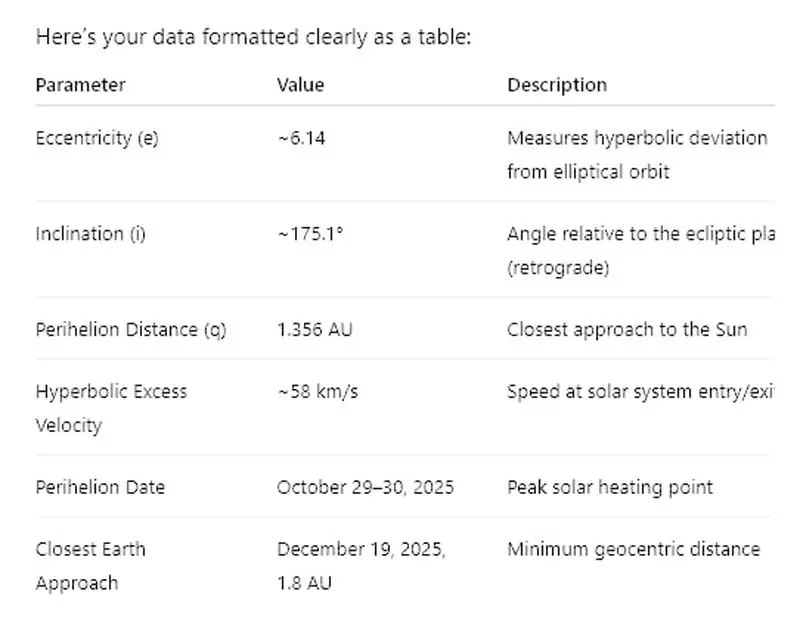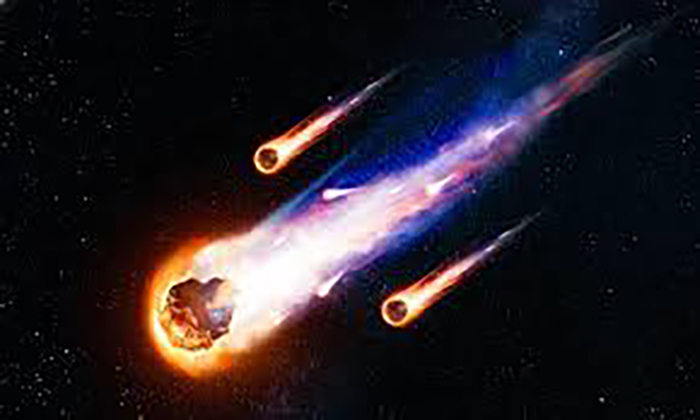Firing a Nuclear Missile at 3I/ATLAS: Is It Possible?
Rokna Social Desk: Scientists have dismissed the idea of firing a nuclear missile at the interstellar comet 3I/ATLAS, saying it is technically impossible and legally forbidden. The comet, which poses no threat to Earth, is moving at nearly 58 kilometers per second—far beyond the reach of any existing missile system.

According to Rokna, citing the reputable outlests, recent research indicates that launching a nuclear missile from Earth to intercept the interstellar comet 3I/ATLAS is, at present, beyond our technical capability. The primary obstacles lie in the comet’s extraordinary speed—approximately 58 km/s—combined with the brief reaction window and the immense energy requirements for interception. Even if such a mission were theoretically achievable, international law, including the Outer Space Treaty, forbids deploying nuclear weapons in space except under extreme planetary defense circumstances—conditions that do not apply to this case. Moreover, the object poses no threat to Earth. While speculative claims about artificial origins persist, most evidence supports the view that 3I/ATLAS is a natural comet. Attempting to destroy or deflect it would be both scientifically wasteful and unnecessarily risky.
The discovery of interstellar objects traveling through our solar system has ignited intense scientific curiosity and occasional speculation. 3I/ATLAS, the third confirmed visitor after ‘Oumuamua (2017) and Borisov (2019), was detected on July 1, 2025, by the Asteroid Terrestrial-impact Last Alert System (ATLAS) in Chile. As an active interstellar comet on a hyperbolic trajectory, it provides an exceptional opportunity to study materials originating outside the solar system. Its appearance, however, has sparked hypothetical debates—chief among them, whether humanity could launch a nuclear missile to intercept or alter its path. This article explores that question from scientific, engineering, defense, and legal perspectives, concluding that such an endeavor remains impractical and undesirable.

Astronomical Profile of 3I/ATLAS
Understanding 3I/ATLAS’s orbital and physical characteristics is crucial before considering any interception attempt. Observations by the Hubble Space Telescope and other observatories reveal that 3I/ATLAS behaves like a typical comet, with a solid nucleus surrounded by a gaseous coma.
Physical Properties:
Size: Estimates of its nucleus size vary due to limited data, but Hubble’s observations suggest a diameter between 0.3 km and 5.6 km, with some ground-based reports pointing to a radius of about 5.6 km—possibly making it the largest interstellar object discovered so far.
Composition:Spectral data indicate a mixture of ices (including water, CO₂, CO, and carbonyl sulfide) and rocky material, consistent with the “dirty snowball” model of comets. The composition suggests it has never closely approached a star before, preserving matter that may predate our 4.6-billion-year-old solar system.
Orbital Characteristics:
Trajectory and Speed: 3I/ATLAS entered the solar system with an incoming velocity of roughly 58 km/s—more than twice the speed of most comets. Its orbit is strongly hyperbolic (eccentricity ≈ 6.14), meaning it will not remain bound to the Sun. The comet’s inclination of 175° indicates it moves in a retrograde path relative to the ecliptic. Its
Key Milestones: Perihelion occurred on October 29–30, 2025, at a distance of 1.356 AU from the Sun, and its closest approach to Earth—1.8 AU—is expected on December 19, 2025, ensuring no risk of impact.

The following table summarizes the orbital elements for reference:

Technical Barriers to a Nuclear Intercept
Intercepting a fast-moving interstellar object like 3I/ATLAS with a nuclear device involves adapting terrestrial missile technology for deep-space operations—a non-trivial task.
Missile Capabilities and Limitations: Conventional intercontinental ballistic missiles (ICBMs), such as the U.S. Minuteman III or Russian RS-24 Yars, achieve speeds of ~7 km/s but are designed for suborbital arcs within Earth’s atmosphere, with ranges under 13,000 km. They lack the propulsion, guidance, and endurance for interstellar pursuits. To reach space targets, a nuclear warhead would need integration with heavy-lift rockets like SpaceX’s Falcon Heavy (escape velocity ~11 km/s) or NASA’s SLS, potentially delivering a payload to interplanetary distances. However, delta-v requirements for matching 3I/ATLAS’s 58 km/s trajectory could exceed 40-50 km/s, far beyond current chemical rockets (max ~15 km/s for multi-stage systems). Advanced concepts like nuclear thermal propulsion (e.g., NASA’s DRACO project) could help, but they remain experimental and untested for rapid missions.
Timeline Constraints: From November 1, 2025, to the December 19 closest approach, only ~48 days remain. Historical missions, such as NASA’s DART (2022), which kinetically impacted asteroid Dimorphos at ~6 km/s, required over two years of preparation. Even expedited launches, like SpaceX’s crewed missions, need weeks for integration—insufficient for custom nuclear payload development, testing, and trajectory optimization. Simulations suggest that for hyperbolic objects, detection must occur at least 5-10 AU outbound for viable interception windows, a luxury not afforded here as 3I/ATLAS was spotted at ~4-5 AU inbound.
Nuclear Deflection Efficacy: Studies on nuclear asteroid deflection, such as those by Lawrence Livermore National Laboratory, indicate that a megaton-class explosion could fragment or nudge a 1-10 km object if detonated nearby (stand-off mode) or on-surface. For comets, however, the porous, icy structure might absorb energy inefficiently, leading to unpredictable fragmentation. NASA’s HAMMER concept envisions multiple kinetic or nuclear impacts for hazardous asteroids, but adapting it for a non-threatening, high-speed target like 3I/ATLAS would demand unprecedented accuracy—hitting a moving object at relative speeds of tens of km/s.
Counterarguments from engineering perspectives emphasize that while theoretically possible with future tech (e.g., laser sails or antimatter drives), current limitations render it impractical. Some simulations for ‘Oumuamua suggested rendezvous missions with existing rockets if launched promptly, but 3I/ATLAS’s higher velocity amplifies the challenge.

Legal, Ethical, and Speculative Aspects
International Law: The Outer Space Treaty (1967) explicitly prohibits nuclear weapons in space, a stance reinforced by the Comprehensive Nuclear-Test-Ban Treaty. While planetary defense exceptions might be argued for imminent threats, 3I/ATLAS’s safe distance eliminates this justification. Violations could provoke geopolitical tensions, as seen in debates over space militarization.
Ethical Considerations: Aggressively targeting a natural object risks destroying invaluable scientific data. 3I/ATLAS’s composition could reveal extrasolar chemistry, and its study via missions like ESA’s Juice or NASA’s James Webb Space Telescope is prioritized. Ethically, assuming good intent in cosmic phenomena aligns with SETI protocols, avoiding “first strike” mentalities.
Speculations and Controversies: Harvard astrophysicist Avi Loeb has speculated that 3I/ATLAS’s size, near-ecliptic alignment, and possible velocity anomalies (e.g., early readings of 26 km/s escalating) might indicate artificial origins, akin to his ‘Oumuamua theories. He posits it as a “rare gift” for study, cautioning against destruction. Critics, including mainstream astronomers, attribute anomalies to observational errors or natural outgassing, viewing it as a standard comet. This debate underscores the need for balanced views: while exotic origins are unlikely (probability <1%), they warrant non-destructive investigation.
Preferred Alternatives
Modern planetary defense prioritizes non-nuclear solutions, including kinetic impactors (as proven by NASA’s DART mission), gravitational tractors, and improved early-detection surveys such as ATLAS and Pan-STARRS. Continuous observation of 3I/ATLAS through instruments like the James Webb Space Telescope and ESA’s Mars Express remains the best way to understand its nature.
Conclusion
Launching a nuclear missile to intercept 3I/ATLAS is neither technically feasible nor legally or ethically justifiable. Its extreme velocity, distant trajectory, and benign nature eliminate any rationale for such an act. Instead, the event highlights the need to improve early-detection capabilities and propulsion technologies for future planetary defense scenarios. For now, 3I/ATLAS stands as a fascinating visitor from beyond our solar system—a cosmic messenger best studied through science, not aggression.
Send Comments